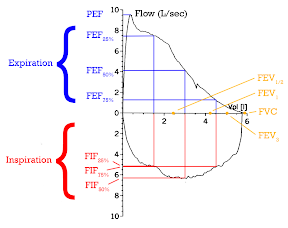Elderly patients with asthma have greater involvement of small and large airways than nonelderly patients
 This study from Japan aimed to clarify the pathophysiologic characteristics among 45 elderly patients with asthma (older than 65 years).
This study from Japan aimed to clarify the pathophysiologic characteristics among 45 elderly patients with asthma (older than 65 years). Elderly patients with asthma had lower values for FEV1, mid-forced expiratory flow (percentage predicted), and ratio of FEV1 to FVC than nonelderly patients with asthma. In CT chest measurements, elderly patients with asthma had greater airway wall thickening and air trapping.
Impulse oscillation measurements indicated that elderly patients with asthma showed greater resistance at 5 Hz (used as an index of total airway resistance), greater decrease in resistance from 5 to 20 Hz, a higher ratio of decrease in resistance from 5 to 20 Hz to resistance at 5 Hz, higher integrated area between 5 Hz and frequency of resonance, greater frequency of resonance, and lower reactance at a frequency of 5 Hz (potential markers of small airway disease).
Based on spirometric, CT, and impulse oscillation analyses, elderly patients with asthma have greater involvement of small and large airways than nonelderly patients with asthma.
References:
Pathophysiological characteristics of asthma in the elderly: a comprehensive study. Hideki Inoue et al. Annals of Allergy, Asthma & Immunology, Volume 113, Issue 5, Pages 527–533, November 2014.
http://www.annallergy.org/article/S1081-1206(14)00555-9/abstract
Image source: Spirometry, from Wikipedia, the free encyclopedia, GNU Free Documentation License.